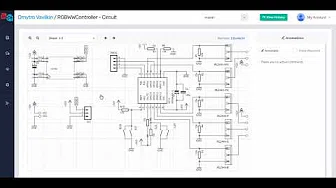Files
Scanning the repository...
README.mdADSR Envelope
This circuit operates by using the LM13700 as a variable current source charging a capacitor. It is configured as a non-inverting op-amp charging the capacitor to a reference voltage
V_refat the+pin with a slew rate limited by the current control. The capacitor's voltage will change linearly based onI_abcuntil it settles atV_ref. Then a bit of digital logic to create a 3-state state machine to select the correctV_refandI_abc.
States:
- Attack:
V_gate=5V,V_ref=V_in,I_abccontrolled byR_attack - Decay:
V_gate=5V,V_ref=V_sustain,I_abccontrolled byR_decay - Release:
V_gate=0,V_ref=0,I_abccontrolled byR_release
The Attack, Decay, and Release knobs control I_abc in each state,
while the Sustain knob divides down V_in to set V_ref in the
Decay state.
A comparator, capacitor, and a few transistors create cheap analog
a flip-flop that turns on when the output hits V_in (flipping from
the Attack state to the Decay state), and turns off when V_gate
turns off.
Voltage control of the parameters could be possible by exposing
access to I_abc, but it doesn't make much sense to me to expose
those parameters with any control other than a knob - it's not the
kind of thing you need to modulate automatically.
Choice of the capacitor and the knob resistance control the time
range. Large values for both mean a longer charge time, but a large
capacitance effects the fastest charge time too, since I_abc is
capped at 2mA.
TODO: power usage








